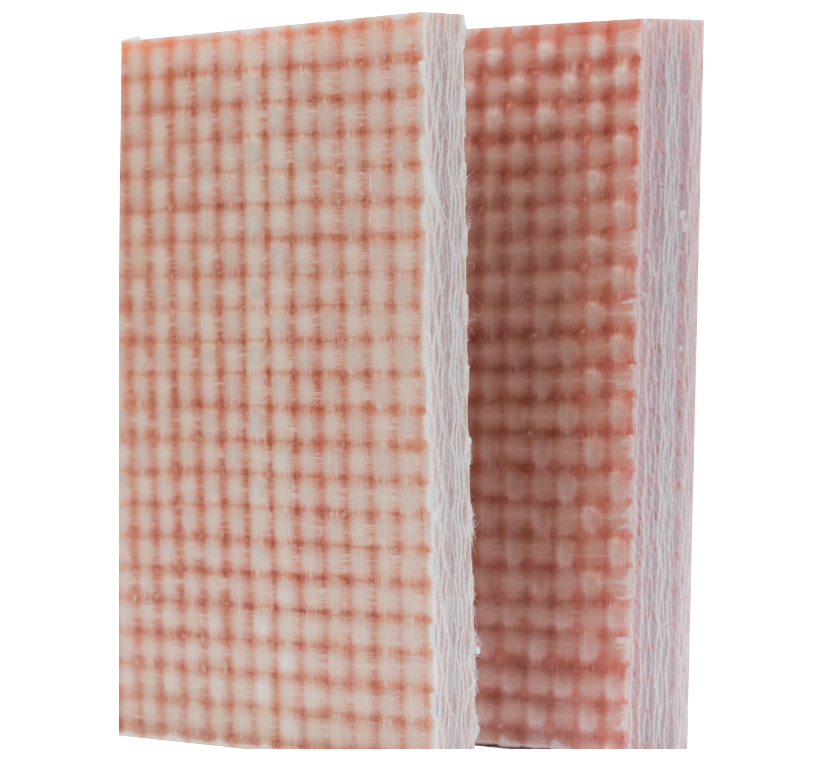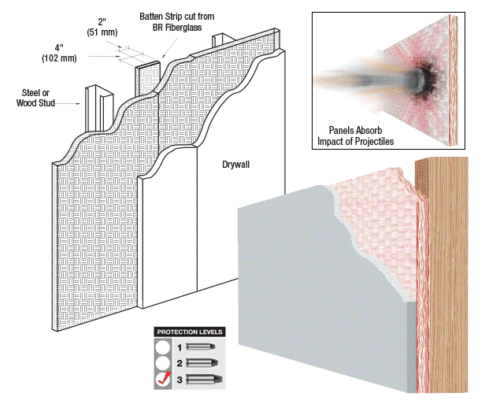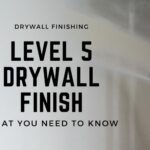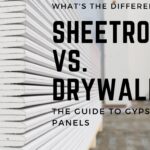Bulletproof and ballistic drywall can seem like a confusing topic until you understand a few basic concepts.
Homeowners create safe rooms while businesses, retail stores, government agencies, and schools install ballistic wall panels to provide protection and peace of mind.
Bullet Proof and Ballistic Drywall
There are many things to know about ballistic drywall even before your construction project begins.
We will discuss how bullet-resistant drywall is rated, how it is manufactured, how to install it, where to buy it, and why it’s essential to various building types around the world.
What is Ballistic Drywall?
Let’s start with the basic definition. Merriam-Webster defines the term “ballistic” as “relating to the science of the motion of projectiles in flight.”
In addition to bullets, “ballistic” can describe a rocket mortar, shrapnel caused by an explosion, or even something as simple as a rock.
Ballistic drywall, or bulletproof sheetrock, is a shield offering protection to building occupants from deflected bullets from handguns and rifles, as well as other projectiles in an active shooter situation.

However, the term “bulletproof” is misleading because there is no such thing as material that is 100% non-penetrable. A better term for “bulletproof sheetrock,” would be “bullet-resistant sheetrock.”
Real-life attacks vary depending on the weapon and the caliber of the rounds. There is no way to test for every possibility, but there are standards set in place for where bullet-resistant environments are required.
How Much is Bulletproof Drywall?
How much are ballistic and bulletproof wall panels? It all depends on the level of protection you are looking for. Generally, a 4’ x 8’ sheet bullet-resistant panel costs as low as $350 per sheet and go as high as $1,800 per sheet.
So costs can range from $10 – $60 per square foot for the material.
But why would you need bulletproof drywall? Let’s take a closer look at what ballistic drywall is, and where its commonly used.
Multiple Levels of Drywall Protection
Regardless of what you call it, “ballistic drywall” is resistant to firearm projectile impacts but will not stop all bullets from penetrating.
It’s classified by how many and what type of bullets it will resist from differing calibers of firearms and can provide multiple levels of protection against varying types of threats.

How it Works: Ballistic panels have a multi-layer construction that absorbs the bullet’s energy in a controlled delamination process, retaining the projectile within its layers.
This reduces the risk of injuries from blast fragmentation and bullet ricochet.
It can also provide a safe haven for building occupants seeking shelter from an armed attack. Ballistic or bullet-resistant wall panels are sized like drywall in flat, rigid sheets, and can be installed with standard hand tools.
What Building Types Use Ballistic Drywall?
Residences, commercial businesses, and government buildings are at risk of an armed attack. Schools and universities can easily be targets of attacks.
From nuclear plants to federal agencies, there is a need to protect employees and customers and give them peace of mind.
Architects specify the use of ballistic and bulletproof drywall for several uses, either to meet building owner demands or to comply with codes and specific regulations.
Generally, bullet-resistant fiberglass panels are used on interior walls of any property that requires a high level of security.
Here is a list of types of buildings that are excellent candidates for the use of ballistic drywall:
- Access points of military bases
- Airports
- Banks and credit unions
- Border posts
- Check cashing companies
- Commercial businesses
- Correctional facilities
- Courtrooms
- Embassies
- Government facilities
- Guard houses
- Gun ranges
- Gun rooms in residences
- Home vaults
- Military installations
- Panic (or safe) rooms in residences
- Pawn shops
- Pharmacies
- Police stations and police departments
- Religious centers
- Retail stores
- Schools including grade schools, high schools, colleges, and universities
- Stadiums
- Night clubs
- Storm shelters
Different Ratings of Ballistic Drywall
The National Institute of Justice (NIJ) standard is the only nationally accepted standard for body armor worn by law enforcement and corrections officers.
NIJ standards rate body armor, whereas ballistic materials are rated by the global safety certification company, Underwriters’ Laboratories, or UL as it is universally known.
The Underwriters Laboratory tests and evaluates components and products, allowing the manufacturer to use a UL certification mark.
UL is one of several companies approved to perform safety testing by the U.S. federal agency, the Occupational Safety and Health Administration (OSHA). Being “UL-listed” means that UL has confirmed that the product is safe for use.
UL752 Certification
It benefits manufacturers to obtain a UL752 level certification, which provides third-party assurance of their products’ performance characteristics. Some ballistic products also comply with ASTM testing standards for flame spread or smoke ratings.
The H.P. White Laboratory also performed ballistic testing for over 80 years until it recently closed.
There are also certain ratings on bulletproof drywall for forced entry protection.
Ballistic Protection Level Ratings
Ballistic protection level ratings are based on the number of rounds and the size of the weapon tested.
Ratings range from small-caliber handguns to high-caliber rifles. UL752 governs the requirements for bullet-resistant material to form ballistic barriers as protection against robberies, holdups, and other armed attacks.
The material is tested to determine whether “protection is provided against complete penetration, the passage of fragments of projectiles, or spalling (fragmentation) of the protective material to the degree that injury would be caused to a person standing directly behind the bullet-resisting barrier.”
This chart shows the UL752 ratings of bullet-resistant material by ammunition type. From 9mm handgun bullets up to 12 gauge shotgun shells, UL 752 covers nine different levels of ratings.
Ratings of Bullet Resistant Materials as Identified by UL 752
| Rating | Ammunition | Weight (grains) | Weight (grams) | minimum fps | maximum fps | Number of shots |
Level 1 | 9mm with Lead Core | 124 | 8 | 1175 | 1293 | 3 |
Level 2 | .357 Magnum | 158 | 10.2 | 1250 | 1375 | 3 |
Level 3 | .44 Magnum | 240 | 15.6 | 1350 | 1485 | 3 |
Level 4 | .30 Caliber Rifle | 180 | 11.7 | 2540 | 2794 | 1 |
Level 5 | 7.62mm Rifle Lead Core | 150 | 9.7 | 2750 | 3025 | 1 |
Level 6 | 9mm Full Metal Jacket | 124 | 8 | 1400 | 1540 | 5 |
Level 7 | 5.56mm Rifle | 55 | 3.56 | 3080 | 3383 | 5 |
Level 8 | 7.62mm Rifle Lead Core | 150 | 9.7 | 2750 | 3025 | 5 |
Shotgun | 12-Gauge Rifled Lead Slug 12-Gauge Buckshot | 1oz 1.5oz | 28.3 42 | 1585 1200 | 1744 1320 | 3 3 |
How is Ballistic Drywall Manufactured?
Drywall with bullet resistance is manufactured by mechanically injecting polyester resin into woven ballistic grade fiberglass cloth by running it through a series of small holes.
The impregnated cloth is then placed in a hydraulic hot press under heat and pressure, resulting in flat rigid sheets.
After removal from the press, the boards are cut to size on a water jet, or semi-automatic beam saw.
Where to Buy Ballistic Drywall
You can find manufacturers of ballistic fiberglass panels in a simple internet search. You can also use an industrial sourcing platform like Thomas (https://business.thomasnet.com/).
This industrial directory contains a broad range of bullet-resistant panels. A few of the top brands are Armorcore, Bullet Guard, and Armortex.

Ballistic Drywall Cost per Square Foot
There’s a wide range of pricing for ballistic drywall panels. A 4′ x 8′ sheet of bullet-resistant fiberglass or drywall panel ranges from $300 to $1,800.
That’s roughly $10 – $60 per square foot. With the increased volatility of material pricing, you will want to be sure and get a project-specific quote for any ballistic drywall you plan to purchase.
Ballistic panel pricing is not the only problem you’ll want to consider when planning your project.
Availability is becoming a huge problem and a significant factor in determining which bullet-resistant materials to use.
Lead times for products can be considerable, so always check with the manufacturer or distributor and verify when each ballistic panel for your bulletproof wall is available for delivery before ordering.
Alternatives to Ballistic Drywall
Several alternative products have been developed to stop ballistic threats, with many more in development.
BallistiCrete –
BallistiCrete is an interior plaster coating providing NIJ Level III and Level IV ratings. The product is mixed and applied on-site, with a natural off-white color.
It’s used bullet-resistant safe rooms and panic room construction.
The product is also non-combustible with zero flame spread and resistant to the growth of mold and mildew. While BallistiCrete does provide some acoustic and soundproofing properties, that’s not it’s primary purpose. The cost of BallistiCrete is too high to consider acoustic ratings on it’s own.
Armorcore Level 3 Bullet Proof Panels
Another alternative to bullet proof drywall and wallboard is Armorcore Level 3 ballistic panels. The woven fiberglass and composite laminate provides energy absorption to stop a bullet.
Armorcore panels have been tested and approved for UL 752 standards. There’s several different products offered, ranging from Level 2, 3, 4, and 7. If you’re interested in Armorcore panels, be sure to price out before hand. Prices range from $700 per panel for level 2, all the way up to $1,900 per panel for level 7.
How to Install Ballistic Drywall
There are a few basic steps of installation instructions for ballistic drywall. It’s not the most common DIY project, but still possible.
First, panels are secured along the edges and reinforced with ballistic fiberglass batten strips.
A final layer of bullet-resistant gypsum board or veneer is applied on top of the shielding.
Ballistic drywall panels are no different in appearance than untreated wall panels.
Panel Sizes
Ballistic panels are typically supplied in combinations of 3’, 4’, and 5’ widths and 8’, 9’, and 10’ lengths.
They can be cut in the field with ordinary carpentry tools, including a circular saw, table saw, panel saw, or saber saw.
A diamond grit blade is the best option for large cuts and cuts around electrical boxes and other openings.
Fastening and Drilling
You can drill through bullet-resistant drywall with high-speed steel twist drills at a slow speed. The panels can be attached to wall studs or substrates with self-tapping drywall screws.
Panels with a nominal thickness of 1 1/8” and thicker can be pre-drilled with fastener holds to facilitate the installation.
You can use a carbide or cobalt tip drill under medium speed and pressure.
Adhesives
You can also affix ballistic drywall by using adhesives. If you are using a non-porous substrate such as aluminum or steel, use a stronger adhesive such as Plexus MA 320. Laminates can be applied with standard contact adhesives.
Wall Assembly
It’s easiest to install bulletproof drywall in new construction, but it’s possible to install in retrofit renovations.
Butt joints and seams can weaken the ballistic properties of the panels. It’s advised to attach a 4” overlap batten strip where the panels meet, ensuring a 2” overlap on each side of the seam.
The batten strips can be attached directly to the panels wherever there are vertical or horizontal joints.
Finishing
You can apply wood, plastic veneer, additional layers of drywall, or a stainless steel sheet to the bullet-resistant panels using contact cement. You can also upholster or paint the panels.
While the material in the panel does not present hazards during storage or use, irritant particles are produced when the panels are cut or machined.
When installing ballistic drywall, workers should always use protective gloves, eye protection, face masks, and protective clothing.
The Future of Bullet Proof and Ballistic Drywall
We live in a day and age when personal protection and security are always on our minds.
Owners of homes and businesses are turning to ballistic wall panels as a solution to living and working in buildings facing a potential threat or hostile environments.
While no drywall can claim to be “bulletproof,” material that is bullet resistant is easy to find, simple to install, and will add a level of security for families and workers across a broad range of industries and businesses.



